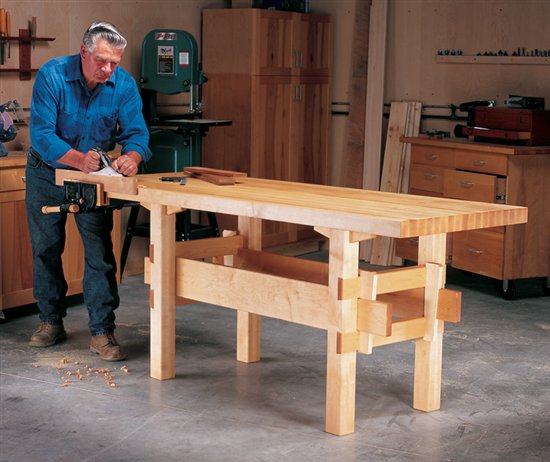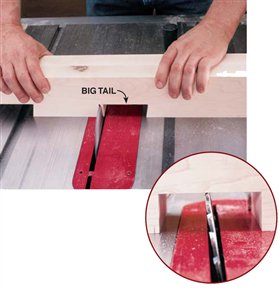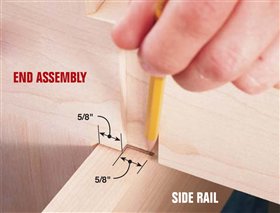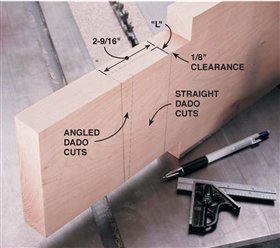We may receive a commission when you use our affiliate links. However, this does not impact our recommendations.

Wedged-Base Workbench
Tablesaw joinery locks it together.
By Tim Johnson
|
This workbench has a top ready for hard use. But it’s the base that
catches your eye. The interlocking joinery, with its dovetails and
wedges, is rock solid, yet it knocks down quickly for moving.
Although it looks complicated, the base is surprisingly easy to build. It’s made from multiples of only five parts that fit
together like the pieces of a puzzle. The
fancy joinery that locks the pieces in
place is nothing more than strategically
located rabbets and dadoes, and they’re
all made on the tablesaw.
|
|

You may also like…
Dream Workbench
Adjustable Workbench
Master Cabinetmaker's Bench
|
|
Cut slots centered in the top of each leg for the brackets
that hold the top (Step A).To keep the leg steady, attach a tall
auxiliary fence to your saw’s rip fence and clamp the leg to a
good-sized rectangular block. Use a featherboard and make the
cut in several shallow passes until you reach the maximum
depth your dado set allows (21⁄8-in., in this case).
|
|

|
|
Cut dadoes on both sides of each top bracket so they
can slip into the dadoes in the leg tops (Step B). Stop blocks at
each end of the miter fence control the width of the cut.
|
|

|
|
Bevel the edges of each end rail at a 9-degree angle
(Step E).These cuts turn the tongues into big dovetail pins.
Leave a 1⁄4-in. wide flat on the back edge of the rail to ride
against the fence.
|
|

|
|
Make angled cuts at the
reference points, turning the leg
dadoes into tails (Step F).Then nibble
away the remaining waste. After cutting
the angle on one side of each dado, flip
the leg over and stand the end rail on the
leg. Align the pin with the unfinished tail, and
mark the leg for the remaining angled cut.
(Inset) Set the height of the blade for cutting the
dovetail corners by raising it so that its teeth barely nick the
top of the dado.
|
|

|
|
Pare the waste from the angled saw cuts with a sharp,
wide chisel to finish the corner.
|
|

|
|
Cut a dado (Step G) in each end rail, starting from the
shoulder of the half-lap. Make it wide enough to house the
side rail.
|
|

|
|
Mark the location of the angled dado in the side rail
that will hold the wedge. Slide the side rail into position and
use the end assembly dado for reference.
|
|

|
|
Lay out the side rail wedge dado from the L-shaped mark
you’ve just made (Photo 7). Its leg gives you the depth and its
stem marks the back of the wedge. Extend the dado a bit behind
this line for clearance. Draw the angled front using one of your
wedges held tight against a try square.You can remove most of
the waste from this dado with straight, 90-degree cuts (Step L).
|
|

|
|
Make the final angled cuts in the side rail (Step M). Use
one of the wedges clamped between the rail and the miter
gauge to guarantee that the angle of the dado and the wedge
match perfectly.
|
|

|
|
Slide the wedge home (Step N). Once it has engaged
the dado in the lower end rail, tap it securely into place.
|
|

|
Sources
Woodcraft Supply, woodcraft.com, 800-225-1153, workbench tops.
Your local home center or lumberyard, kitchen countertops.
The story originally appeared in American Woodworker October 1999, Issue #75.

|
|

Purchase the complete version of this woodworking project story from AWBookstore.com.
|
Product Recommendations
Here are some supplies and tools we find essential in our everyday work around the shop. We may receive a commission from sales referred by our links; however, we have carefully selected these products for their usefulness and quality.





















